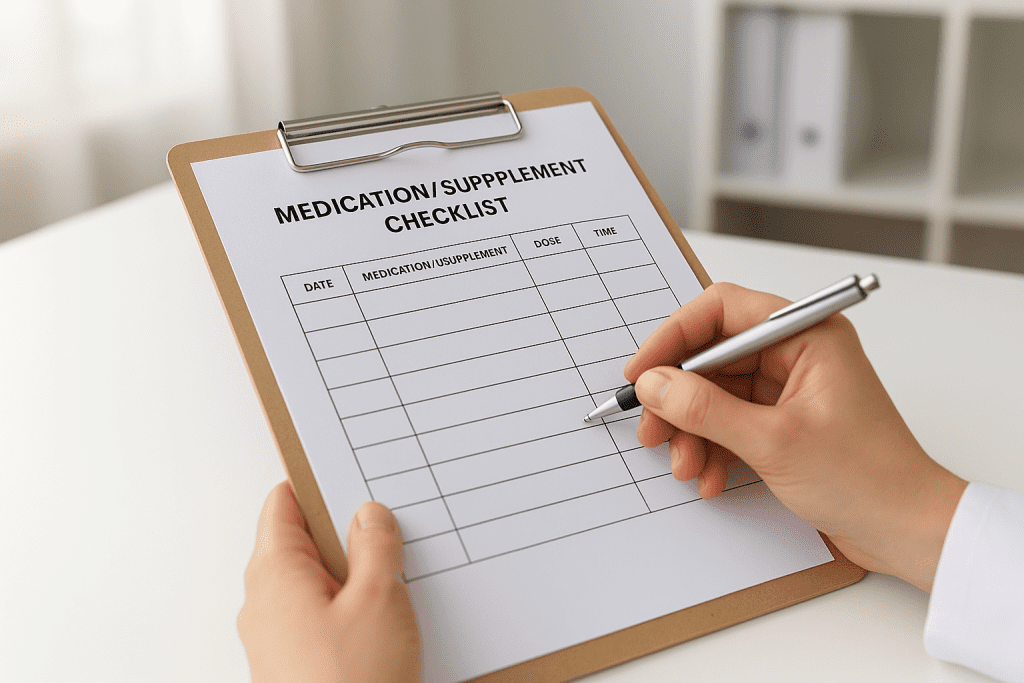Mixing supplements with prescription drugs may seem harmless, but it can trigger dangerous side effects. That’s where a reliable drug interaction checker becomes essential.
This guide breaks down the most clinically significant supplement-drug interactions, who is most at risk, and what health professionals recommend for safer combinations.
From statins and grapefruit to thyroid meds and calcium, you’ll learn how to spot the red flags and protect your health.
Summary / Quick Answer
A drug interaction checker helps identify risky combinations between dietary supplements and prescription drugs. Key interaction categories include:
- Statins + Grapefruit Juice: Raises blood drug levels; risk of muscle damage
- Warfarin + Herbal Supplements: Alters clotting, bleeding, or clotting risk
- Antidepressants + St. John’s Wort: May trigger serotonin syndrome
- Levothyroxine + Calcium/Fiber: Blocks absorption; thyroid levels unstable
- Metformin + B12 Deficiency: Long-term neurological risk
Always check interactions using a tool like Drugs.com, and speak to your pharmacist for personalized guidance.
Statins, Grapefruit, and Red Yeast Rice: The CYP3A4 Trap

Think statins are safe with breakfast? Think again if grapefruit juice is on your plate. Several statins (simvastatin, lovastatin, atorvastatin) are broken down by CYP3A4 enzymes in your intestines. Grapefruit juice inhibits these enzymes, which can raise drug levels by over 4x, leading to side effects like rhabdomyolysis – a serious muscle breakdown.
Another culprit? Red yeast rice supplements. They contain monacolin K, chemically identical to lovastatin, and show stronger inhibition of key enzymes than the drug itself. Unlike prescription statins, supplement content varies, increasing unpredictability.
| Interaction | Result |
|---|---|
| Grapefruit + Statins | Elevated blood drug levels, muscle pain |
| Red Yeast Rice + Statins | Overlapping effects, higher toxicity risk |
If you’re on statins, check out our Statins and supplement risks guide and the Grapefruit danger list to stay safe.
Warfarin and Herbal Supplements: A Delicate Balance
Warfarin’s blood-thinning effects make it especially vulnerable to supplement interference. While CoQ10 and Ginkgo biloba seem safe in standard doses, others like garlic can tip the scale dangerously toward bleeding.
This risk escalates due to warfarin’s narrow therapeutic window and its dependency on vitamin K balance. Even modest vitamin K intake can interfere with its effect. That’s why patients need regular INR testing and should follow a consistent dietary routine.
Key high-risk combinations:
- Warfarin + High-dose vitamin K
- Warfarin + Garlic or ginseng
- Warfarin + Omega-3s (in excess)
For a complete protocol, see our Warfarin interaction protocol and understand Vitamin K’s clotting mechanism.
St. John’s Wort, SSRIs, and Serotonin Syndrome Risk
St. John’s Wort may seem like a gentle herbal remedy, but its effects on neurotransmitters can be potent. It’s known to interact dangerously with SSRIs and other antidepressants, increasing the risk of serotonin syndrome.
This syndrome can present with:
- Agitation or confusion
- Elevated pulse and temperature
- Muscle rigidity or tremors
Clinical studies show that even though St. John’s Wort may work for mild depression, mixing it with medications like sertraline or fluoxetine can be hazardous.
Use our SSRI compatibility checklist and learn the Serotonin syndrome symptoms to protect your mental and physical well-being.
Thyroid Medications and Supplements: Timing Is Everything

Levothyroxine, the mainstay for hypothyroidism, is highly sensitive to interference from common supplements. The worst offenders? Calcium carbonate, iron, and fiber.
The issue is physical binding in the gut, which prevents absorption and causes TSH levels to rise, destabilizing thyroid control. One study showed that a 64-year-old woman’s TSH jumped from 2 to 9.8 mIU/L within weeks of starting calcium.
Tips for timing:
- Take levothyroxine 30–60 minutes before breakfast
- Wait at least 4 hours before calcium or iron
- Consider liquid levothyroxine for better absorption
Read our Thyroid medication timing guide and explore Supplement timing strategies to optimize your routine.
Metformin and Nutrient Depletion: The Hidden Deficiency
Metformin is a staple in type 2 diabetes management, but long-term use can lead to vitamin B12 deficiency, particularly in adults over 65. This happens due to impaired absorption in the intestines, which worsens when combined with PPIs.
Signs of B12 deficiency include:
- Fatigue
- Memory issues
- Tingling in hands and feet
Annual B12 testing is recommended after 2–3 years on metformin, and sooner if PPIs are also prescribed.
Explore our full report on Metformin B12 depletion and what lab values to track.
Immunosuppressants and Herbal Products: A Dangerous Mix
For transplant recipients and autoimmune patients, drug levels must remain within a narrow therapeutic range. That’s why herbal interactions with immunosuppressants like cyclosporine can be dangerous.
- St. John’s Wort can lower drug levels, risking organ rejection
- Berberine, ginger, or CBD may increase drug levels
- Many herbs like Echinacea show inconsistent effects
Healthcare teams must screen for all supplements during medication reviews. See our Immunosuppressant herb risks for a complete breakdown.
Personalized Risk Factors and Genetic Considerations
Genetics play a major role in how supplements and drugs interact. Variants in CYP2C9, CYP2C19, and CYP3A4 can make someone a poor metabolizer, increasing risk.
These genetic differences explain why two people may react very differently to the same grapefruit-drug combo or warfarin dose. Seniors, in particular, face higher risks due to slower metabolism, polypharmacy, and nutrient depletion.
See our CYP450 enzyme guide and Elderly polypharmacy guide to learn more.
How to Use a Drug Interaction Checker

A reliable drug interaction checker like DrugBank or Drugs.com can prevent avoidable side effects. Here’s how to make the most of them:
- Enter all prescription meds
- Add supplements, including herbal and vitamins
- Review flagged interactions
- Use our Personalized medication review template to log findings
- Ask your pharmacist – see our Pharmacist consultation tips
These tools can’t replace clinical judgment, but they’re a powerful first step toward safety.
Conclusion
Supplement-drug interactions are more common and serious than most people realize. Whether you’re managing diabetes, depression, or thyroid issues, it’s essential to recognize combinations that increase side effects or reduce effectiveness.
A good drug interaction checker isn’t just for pharmacists – it’s a tool everyone should use.
To stay safe, always disclose supplements to your provider, time your intake wisely, and stay up to date on high-risk combinations.
Explore more with our guides on Natural ≠ safe myth and Emergency red flags everyone should know.


